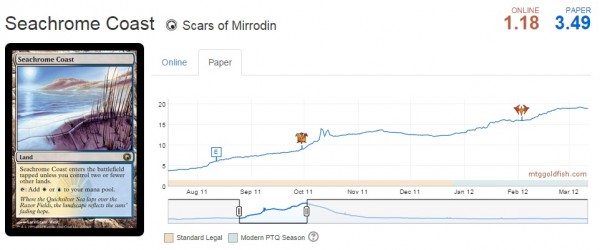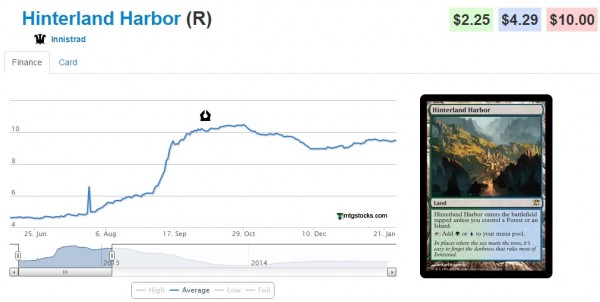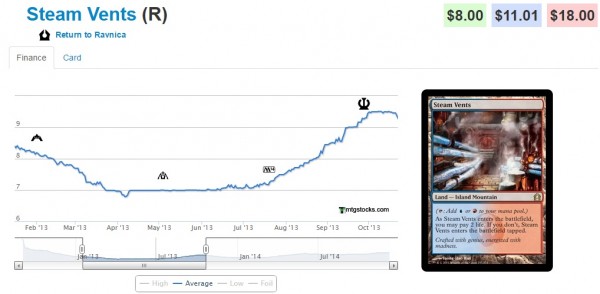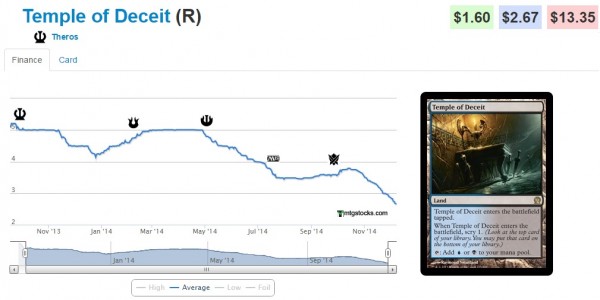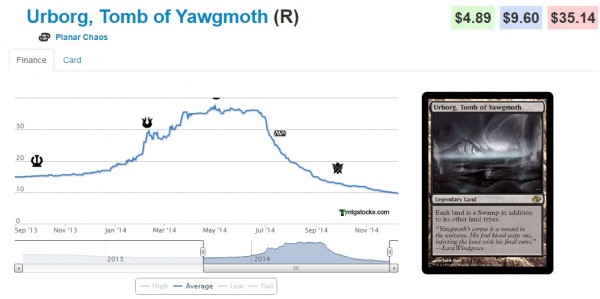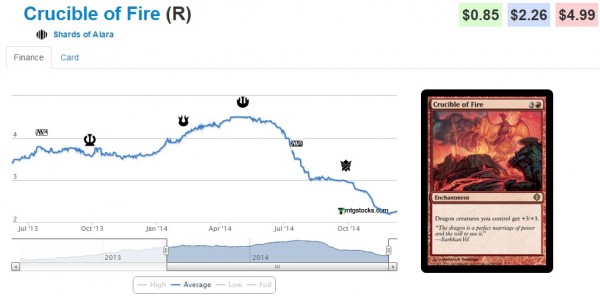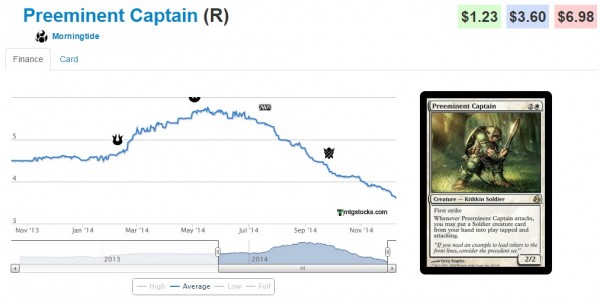Are you a Quiet Speculation member?
If not, now is a perfect time to join up! Our powerful tools, breaking-news analysis, and exclusive Discord channel will make sure you stay up to date and ahead of the curve.
Welcome back readers and speculators!
The purpose of this site is to help players make money with this awesome hobby/game we all love. I take a rather liberal view (and this is one of the rare occasions I can say that) when it comes to this creed, by which I mean, I personally believe that one way to "make money" is by not losing it. Sometimes it's important to focus on the reasons not to buy something rather than get washed up in all the hype, which is why my fellow writers and I usually parrot the saying "sell into the hype". That being said, let's look at some lessons I learned this year.
Lesson: Patterns Aren't a Guarantee
Both the past two Standard-legal rare land cycles saw significant gains when the block after their printing became legal. Many of us (myself included) expected the Theros Temples to follow suit.
What I Learned
Rare mana fixing lands aren't a guarantee. The most important difference between the scrylands and the previous three rare lands was that the scrylands are bad for aggro decks (which often have a pretty big footprint in Standard) because they always come into play tapped, though they fit well in many control style decks.
But that logic isn't enough, because that would imply that while the aggro colored lands (Temple of Triumph, Temple of Abandon) could be really cheap, the control ones (Temple of Enlightenment, Temple of Deceit) should have gone up. And they seem to do okay in midrange decks, which are a large portion of the metagame now.
So we can look at how often they are played. Looking over the most recent SCG Standard Open, we have an average of 5.75 per deck.
If we compare that to the Innistrad lands in the previous format we'd see around 4.125 and before that looking back at the Scars lands we'd see closer to 4 per deck. So it doesn't appear that the Temples are seeing less play than previous rare land cycles.
Instead it is more likely that Magic is a victim of its own success. With the rapid growth of the MTG playerbase the last few years more and more packs have been opened with each new set (compared to the similar set the year before). This just means that in all actuality there are likely just a lot more Temples in the marketplace than there were Innistrad lands or Scars fastlands.
However, if the competitive-to-casual ratio remained the same this wouldn't hold true. If I have 300 players in my area but only 50 competitive players who want the lands then the demand for the tournament staples should be the same if I have 3000 players in my area and 500 competitive players.
Granted, this is a massive oversimplification as there's no guarantee that each player will open the same number of packs, but overall, I feel safe making this assumption. As the Temples have actually dipped downward (save Temple of Malady which seems to have held steady), this actually implies that the casual player base has grown at a higher rate than the competitive player base.
Lesson: Diversification Isn't Always a Great Strategy
When you talk to a stock portfolio manager one of the first things they usually bring up is "portfolio diversification," which is synonymous with risk mitigation. The idea being that by having a lot of different stocks, when one drops terribly you don't lose as much of your portfolio.
The problem here is that stocks are much easier to sell than Magic cards. So if a stock is starting to plummet you can usually unload it relatively quickly, whereas a Magic card that starts to plummet is much harder to sell--often because people will keep listing or re-listing copies below the current lowest price, which turns into a race to the bottom where players are weary of buying a card they see keep dropping.
To make matters worse, when your desire is to buylist, then it's easier to do so if you have a lot of copies of a few cards than a few copies of a lot of cards. This is even more true if you buylist as I do, picking a couple stores and pulling out cards they're paying well on, rather than just sending stuff off to whoever has the highest buylist price and losing potential profits to shipping fees.
What I Learned
While it's important to have some diversity in your MTG speculation portfolio it can easily snowball out of hand. When I started my "spec" box, my original intent was to just put away a few cards here and there. Either ones I thought were underpriced at the moment (usually EDH cards, including a lot of the Primordials from Gatecrash) or banned cards which were at their floor, but given an unbanning would likely skyrocket (looking at you Mental Misstep). This slowly grew to include just about any cards I felt had more potential to go up than down.
Now I have an almost full box that has cards ranging from Skaab Ruinator to Snapcaster Mage in value. To make matters worse, when you begin to just throw anything with potential in, then you lose track of what's actually in the box. You also lose potential trades involving those cards because you don't carry them on you.
Lesson: Casual Cards Aren't a Safe Long-Term Bet
This year we saw quite a few casual cards get reprinted, causing their original cards to tank pretty hard.
The reprinting of these cards caused even the originals to drop in value (often by 50% or more). Even worse, their inclusion, albeit in a core set, seems rather arbitrary (though many think that Crucible of Fire is a plant for Khans block).
The point is, WoTC is clearly aware that the casual crowd is the main driving force for pack sales, so it's smart to appeal to them. Many of us (at least those reading this article) likely view MTG from the perspective of card values and when you crack a Crucible of Fire in a pack you likely think, or possibly let loose, a series of expletives, but there are still a lot of players out there who are thrilled no matter what the rare is. They don't see a bulk rare, they see an enchantment that makes all the dragons in their dragon deck even more ridiculous.
What I Learned
Even just a few years ago, many of us were of the mindset that WoTC would focus on new cards with new mechanics and thus the older ones that had casual appeal would slowly appreciate in value for a long time. But we're seeing that WoTC has no problem sprinkling them into sets. All of my previous examples were from the core set, which is having it's last hurrah next year--but I honestly don't expect WoTC to stop throwing in casual reprints in sets.
This being the case, I'm no longer going to just simply hoard all the casual cards at the cost of trading them at their current value for more desirable cards. Now, I'm not saying you shouldn't look at your casual cards differently. For example if someone asks me for a set of the Gatecrash Primordials, I'm not going to price them at the current TCG-Mid, instead I'll use that and add a profit I'm comfortable with and explain my reasoning. If my trade partner accepts that then the trade can continue; if they don't, then I just hold onto my Primordials until they go up or get reprinted.
Lesson: Buylists Give You Power
This was a pretty important, but easy lesson to learn. Thanks to this site giving all of us access to Trader Tools #3, one can very quickly and easily determine what the best buy price is on a card. While the purpose of a buylist is supposed to be so a store can restock, and prices should rise/fall with demand, a lot of stores are pretty lazy on this front. Granted it can be a massive endeavor to properly maintain a buylist, but more and more I see a lot of stores just default to a percent (and more often than not it's 50%).
Of course the more diligent/active a store is with its buylist the more likely they are to get cards...if they have been out of a fetchland for two weeks it's wise to raise the buy price until people actually start sending them in, otherwise they lose potential sales.
The point is, they want your cards and they want to pay you for them. You have every right to ask for a price on your terms (after all, they ask for certain prices when they sell the cards) and the worst they can do is say no. The closer to retail price you get the more "no thanks" you'll get from stores, so you need to weigh that when deciding how much you want for them.
What I Learned
As I mentioned, maintaining a buylist (in an "ideal" world) requires constant updates and management; because many stores can't or don't want to allocate resources for this, their buylists are often out of date. Trader Tools shows us which cards are more in demand (via lower spreads) and what a reasonable offer on our cards should be from a store.
That being said, many stores are perfectly willing to work with you if you know what your cards are worth and what you want for them. In GP NJ I buylisted over $500 worth of random cards to dealers. Often times, some of the buyers would throw a lower price back at me, and I'd just say "no thanks, someone will pay that here" and many times, they accepted my original price because I knew what my cards were worth (though I can't fault them for trying to get them cheaper...it's a business after all). So you don't always have to take the first price they offer and you can negotiate with most of dealers.


